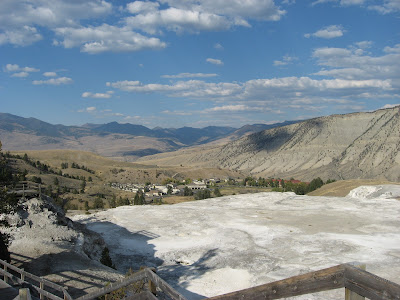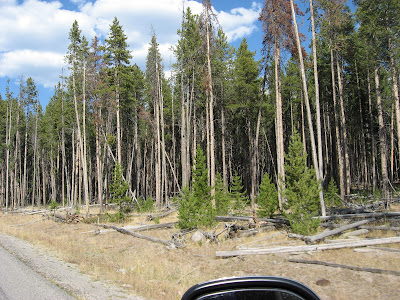Day 2 in Yellowstone was a BIG day for us. We started out
finding these gals relaxing in the river:
And the Bull of the group:
After that eye-opening experience, we continued on to more geysers.
These are bubbling constantly.
Finally, lunch at this picnic table by this stream!!
From here, we drove north all the way to Mammoth Hot Springs (near the north entrance).
Here is a map:
This was the scenery along the way up there. More mountains on this drive.
These pictures were in the Mammoth Hot Springs area.
This area overlooks Fort Yellowstone.
The Army set up a tent camp near Mammoth Hot Springs, which eventually evolved into Fort Yellowstone, which the army continued to use until they turned over control of the park (and the fort) to the then newly-formed National Park Service in 1918. The National Park Service used Fort Yellowstone as Yellowstone National Park's headquarters, which has continued to this day.
These elk were just enjoying the afternoon and the onlookers. But there was a Park Ranger in the area at all times watching both.
There are several houses along this street that are occupied year round by Park personnel.
The Mammoth Hot Spring Terraces have been a popular feature in Yellowstone since the early stagecoach routes up the Yellowstone River Valley. The Terraces, first described by the 1871 Hayden Survey, were given the name of White Mountain Hot Spring, even though they were well known and named before then.
The step-like terraces form as heated water moves along the Morris-Mammoth Fault. The hot water carries dissolved calcium and bicarbonate to the surface of the terraces where pressure lessens. Carbon dioxide then escapes as gas and the carbonate combines with calcium to precipitate as travertine.
The Mammoth Terraces are constantly changing shape and color. Springs which were active one to five years ago may be dry and lifeless now, yet activity may later resume. Along with changes of thermal activity come changes in color. Fresh travertine is bright white in color and as it weathers it changes to gray. Bright colored cyanobacteria and algae mats which were dependent upon a stable temperature and a flow of water also change as the microorganisms die creating a stark, bleak landscape.
LIBERTY CAP
Expedition for its resemblance to the caps worn by colonial patriots in the Revolutionary War. The cone formed from a steady flow of hot water emerging from a single source, depositing dense layers of travertine. The cone continued to grow as long as there was a source of water. Either the hot water spring found a more convenient underground channel to escape through or the orifice became sealed by travertine deposits. It is now an inactive spring and it is not known when Liberty Cap became extinct. The weathered outer surface now supports a plant community of lichens, grass and even a small tree.
ORANGE SPRING MOUND
There are several terraces in this area (like the one below) but I don't remember which one this is.
Scenery along the way back to West Yellowstone and end of Day 2:
This guy seemed to be all alone, but was too busy eating to pay any attention to any of the onlookers!
Stay tuned for Day 3!!















































Wow! I cant believe there are actually places like this. I really need to get farther than Fort Worth in the United States! Thanks for updating Dad. We love knowing exactly what you are doing .
ReplyDelete